Could This Be The Best Performance Car In The World Today?
Let's see now. You've got your Ferrari 458 Italia, your Porsche 911 GT2 RS and 911 Turbo S and Lamborghini Gallardo Superleggera 570-4. After all, if we're setting the scene properly on the most important supersports car inauguration in quite some time – the 2012 McLaren MP4-12C – we should, in this first privileged go, at least be keeping our minds on sub-12-cylinder mid- and rear-engine road beasts. For now, that is. So if anyone brings up the 2012 Nissan GT-R or Dodge Viper SRT10 ACR, that'll be us snapping your back side with a wet towel at the health club. You've been warned.
Before we've dropped into the Recaro support-o-rama seats of the MP4-12C, one of the Queen's lairds of the realm announces, "Be prepared to drive the best handling sports car in history." What do you say to Sir Ron Dennis, boss of the newly formed McLaren Automotive Company (a.k.a. the MAC daddy), when he puts pressure on like that? It's like Bill Gates looking at us and asking enthusiastically, "So, don't you just love that Windows 7?" What happens if you don't?
But as luck would have it, the 2012 McLaren MP4-12C is quite possibly the best handling supersports road and weekend track car in history. Yes, this will certainly take some 'splainin', but bear with us. We're just pleased that no royal beheadings will now be called for, as Sir Ron is not renowned for his merciful treatment of dissenters.
Continue reading...
2012 McLaren MP4-12C - Click above for high-res image gallery
Let's see now. You've got your Ferrari 458 Italia, your Porsche 911 GT2 RS and 911 Turbo S and Lamborghini Gallardo Superleggera 570-4. After all, if we're setting the scene properly on the most important supersports car inauguration in quite some time – the 2012 McLaren MP4-12C – we should, in this first privileged go, at least be keeping our minds on sub-12-cylinder mid- and rear-engine road beasts. For now, that is. So if anyone brings up the 2012 Nissan GT-R or Dodge Viper SRT10 ACR, that'll be us snapping your back side with a wet towel at the health club. You've been warned.
Before we've dropped into the Recaro support-o-rama seats of the MP4-12C, one of the Queen's lairds of the realm announces, "Be prepared to drive the best handling sports car in history." What do you say to Sir Ron Dennis, boss of the newly formed McLaren Automotive Company (a.k.a. the MAC daddy), when he puts pressure on like that? It's like Bill Gates looking at us and asking enthusiastically, "So, don't you just love that Windows 7?" What happens if you don't?
But as luck would have it, the 2012 McLaren MP4-12C is quite possibly the best handling supersports road and weekend track car in history. Yes, this will certainly take some 'splainin', but bear with us. We're just pleased that no royal beheadings will now be called for, as Sir Ron is not renowned for his merciful treatment of dissenters.
Continue reading...
Photos courtesy McLaren Automotive
One thing that does need explaining is the rather unconventional gallery of photos we've lined up. First, the three cars we were handed over to drive in southern Portugal were not finished cars and they were not even considered pre-production units. North American deliveries begin at the start of September 2011 following the UK/Western Europe launch in mid-May.
These three MP4-12Cs were specifically set up to be dynamics verification mules. Regardless, we didn't care, since they seemed pretty finished to us and we felt like geeked lottery winners. Trouble is, McLaren didn't want too many close details of the cabin, exterior or engine. Between this and the limited time we had to grab on to each of these three alphanumeric Brit bullet cars, we trust you'll forgive and forget this bad form. We'll make it up to you with heartfelt conformity from here out.
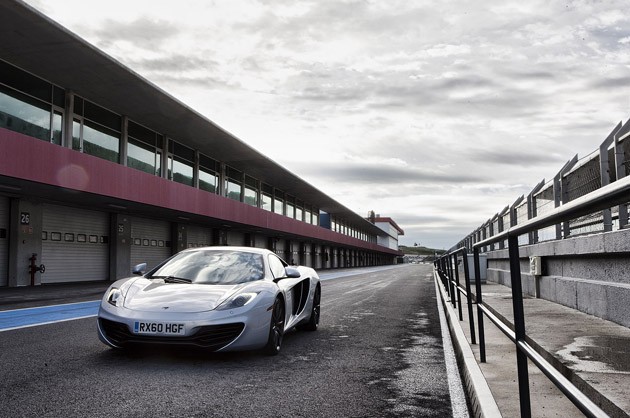
The track to which we were airlifted is the fairly new 2.9-mile, 17-curve autodromo at Portimão. If we were looking for a challenging layout with a myriad of ups, downs and several blind crests, by gum, we've found it in Portugal. On this day, too, we had every type of weather from sunny dryness to unseasonably cold windy drizzle. This was as complete a test as we can remember having in a car this extreme.
So, the scene is set. But first, what do we all think of the looks of the car? Our answer could take up this entire first-encounter review. The man responsible for overseeing the McLaren MP4-12C to completion is renowned multi-national Frank Stephenson of Mini Cooper and BMW X5 fame, among others. As with any of these big moments, Stephenson and his team have heard every single "From that angle it looks like a..." comment you can come up with, so we spared them. Honestly, in our eyes, the MP4-12C looks comfortingly most influenced by the legendary McLaren F1 built from 1993 through 1998. We imagine a few mouthbreathers criticizing the design as a "total rip-off of the Ferrari 458 Italia and Lotus Evora." We take comfort in the fact that these individuals are wrong.
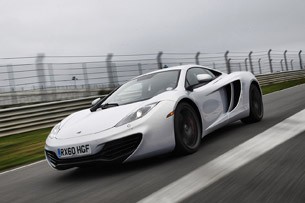
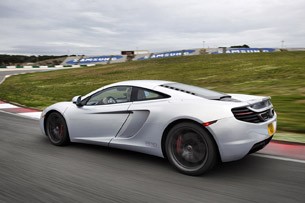
These bold lines can be polarizing, we know. Such aggression – for us the gaping twin side air intakes to the engine radiators stand out – are bound to cause both heated and cooler reactions. But, c'mon, it's mostly hot. The only other spot where we paused, folded our arms, and acted like we were pondering something we knew a lot about, was the rear fascia. Its flushness of all elements seems a bit out of rhythm with the rest of the car. Not even a slightly protruding exhaust blunderbuss. Still, it's pretty hot...
Since the default comparo with this first 21st-century McLaren with 592 horsepower aboard will, right from the start and maybe for its whole life cycle, be the 570-hp 458 Italia, we need to see how their physical dimensions differ. In length, width, height and track widths, the McLaren is anywhere from 1.1 inches (overall width) to half an inch (overall height) smaller than the Ferrari. However, the McLaren is eight tenths of an inch larger in its wheelbase. Cargo-wise, the 458 Italia is a veritable Winnebago when compared with the MP4-12C: 8.1 cubic feet compared to the Brit's 5.1, just a bit smaller than the Lotus Evora at 5.7 cubed feet.
For those of us driving Earth-bound cars, the McLaren is roughly the same length as a Dodge Nitro, impertinent though that fun fact may sound.
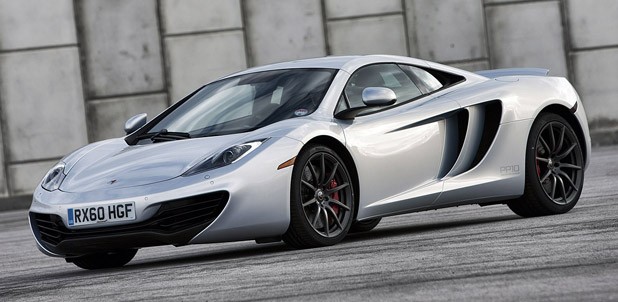
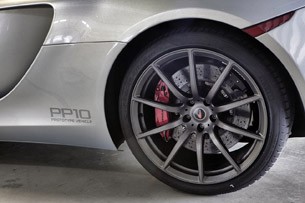
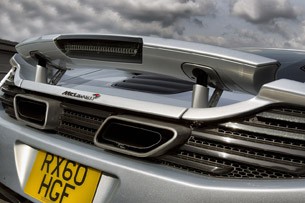
The challenge for the McLaren immediately becomes how to make the cabin not feel pinch-y and not feel short of headroom. Notice first the very skinny lower center console and tunnel with only cleanly consolidated chassis and powertrain controls, along with transmission buttons for the dual-clutch Seamless Shift Gearbox. Half of what is normally found in the middle has been split off and placed on the swooping and wide-enough outer armrests. Not only does this make human comfort normal, but it also shifts that ballast of flesh toward the center of the car, which can only benefit driving dynamics. Very clever.
The center of gravity and yaw point of the MP4-12C are both lower down than either Ferrari or Porsche can achieve currently, so something good is bound to come of this out on the autodromo. One immediate help is that there turns out to be plenty of headroom and also plenty of outward visibility in most important directions.
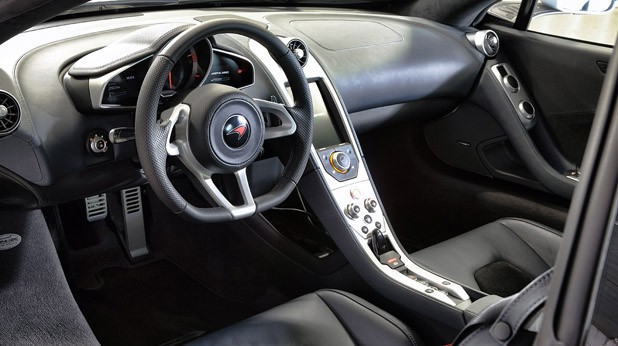 c
c
We need to check out the command center at our right hand. There are two chief clusters: "H" means Handling and it sets the suspension, steering and ESC between normal, sport and track; "P" means powertrain and has the same modes for throttle-engine mapping, gearshifts, as well as management of the intake plenum tone inside the cabin. To play around with these settings – including the "Aero" button at the center of the H cluster for fixing the air-brake rear wing at 15 degrees and the "Manual" button of the P cluster for the transmission – you always need to first poke the "Active" button right at the center of all things.
One more sign that we're dealing with a work-in-progress is that the onboard diagnostics/calibrations/sat-nav screen is frozen on a line drawing of the Portimão circuit. When our next drive happens in May, we'll be able to tell you whether it thrills or stinks.
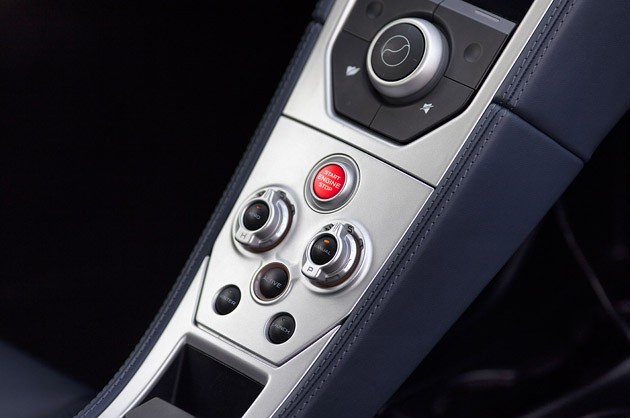
And then we start the all-British brand's new engine, a 3.8-liter bi-turbo that sits in a sturdy aluminum cradle at our back. Being a bi-turbo, the McLaren doesn't scream or holler at us like a Ferrari or Lamborghini. Track dry and emotions gushing, we set everything in Track mode in short order, also lighting up both the Aero and Manual buttons. After a learning-permit lap, we set loose aiming for apexes and the occasional rumble strips.
What happens next is a lot like seeing the light.
There is so much about the McLaren MP4-12C that's working with the driver to make certain that he or she has a thoroughly amazing experience, its perfectly designed steering wheel moving fast, cutting left and right, braking hard and learning the throttle strategies on curve exits.
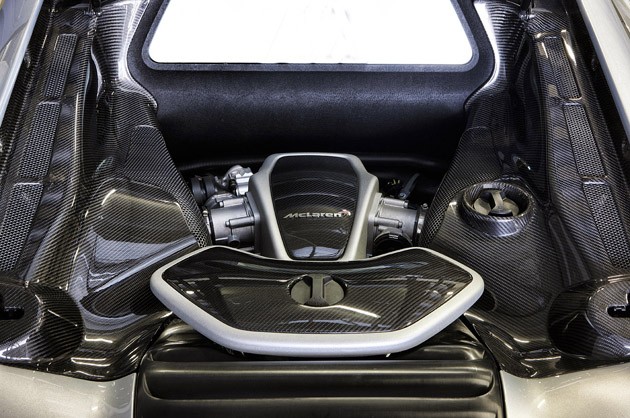
The chief bit of amazingness here is the McLaren ProActive Chassis Control. The MPCC system's adaptive dampers with hydraulic roll control perform sensational duty under the highest lateral g-forces and with no help from any anti-roll braces front or rear. In the same sense, there is no nose-dive under the most torturous braking, nor any lift while exploring launch control.
As revelatory to the seat of our pants as the dynamic tech of MPCC is the sensation of the chassis under us talking swiftly between the four corners. There's a constant feeling of grappling – very rapidly, mind you – for the asphalt, because the more the Pirelli P Zeros (19-inch front, 20-inch rear) stay on land, the faster we will certainly be going for a whole lap. It takes time to get used to, but after a while we were just using it for all it was worth. In a few curves, we actually had images of an Ariel Atom V8 flash through our head. It's that good and liberating once you're at one with it.
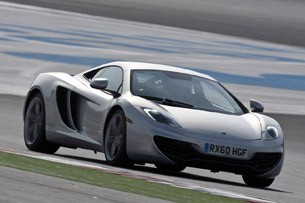
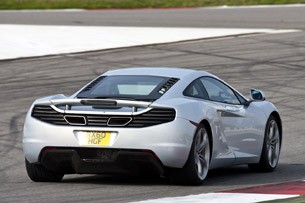
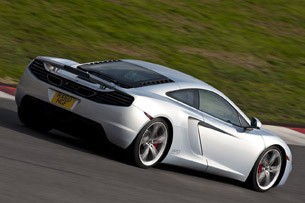
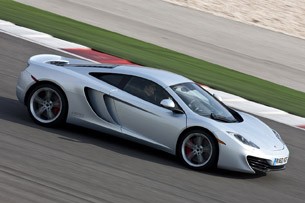
A secondary player to MPCC is the rear-axle Brake Steer, a direct carryover from McLaren's deep Formula One experience. This electrically-activated torque-vectoring-like system lightly brakes the inside rear wheel on curve exits if it senses wasteful wheelspin wanting to happen. The result is that the car stays perfectly on line and faithful to the driver's steering trajectory. We were starting to impress ourselves, whereas in a 458 Italia (while massively impressive) there is always a sense that this next curve could be overcooked and rather expensive. The differences are ever so slight, but at least at first blush, the McLaren wins it outright. A normally humble chief test driver Chris Goodwin on a hot lap says to us after scorching through the very technical first sequence of curves and elevation changes at Portimão, "There's no other car that could do that section that quickly." And this, under no pressure from Lord Dennis.
Amidst all of this barreling along and exhilaration, the A-Number-1 ingredient is lightness. Talking the lightest trim of the car while it is drained of all fluids and just sitting there as a finished work, the MP4-12C weighs 2,868 pounds. The best the 458 Italia can currently do is 3,042 pounds. This particular difference is palpable since both cars share a fore/aft weight distribution of 42.5/57.5 percent. Our last Mac-Ferrari comparison: the fastest MP4-12C trim gets to 60 mph from a stop in just 3.0 seconds flat, while the 458 Italia makes it there in 3.2. Let out to 125 mph (200 km/h), the Ferrari needs near 10 seconds, while the two 21.8-psi turbos of the McLaren and with 443 pound-feet of torque cranking between 3,000 and 7,000 revs, make it there in a stunning 8.9 seconds. That's quicker than a Ferrari Enzo ever did it, leaving only the Bugatti Veyron as the Mac's only straight-line competition.
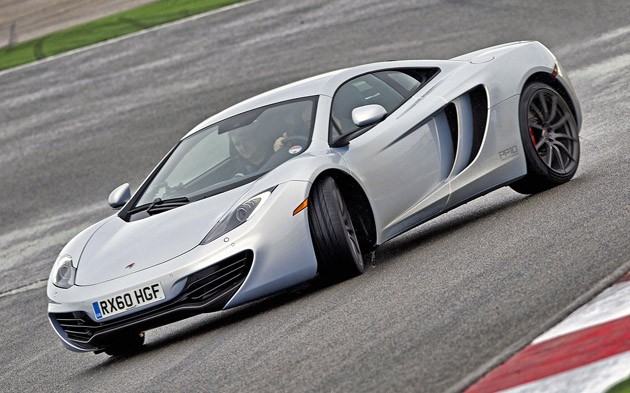
The SSG seven-speed is a pleasurable learning experience as well. With the hand-shifts happening through a clever (and very racy) rocker arm fixed to the steering column, up and down the gears we go. Once we got cozy with the Pre-Cog feature, we were practically creating excuses to use it a lot. It's just like an auto-focus stop on your digital camera. On upshifts especially, we were pre-cogging at around 7,000 revs, which sets up the next gear, and then taking the shift at 7,500 revs. Instantaneous is as instantaneous does, Bubba. Get the hang of it and it's not just entertaining, but you're, once again, shaving time off laps.
We want more noise from the twin exhausts, so we'd opt for the sport pipes that raise the racket. It's the price one pays for the muffling effect and lower overall rev patterns of a bi-turbo. In sport or track modes, at least, an acoustic tube runs from the intake plenum to the rear wall and that makes for great orchestrations while slicing and dicing along.
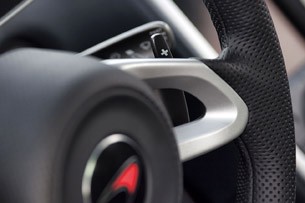
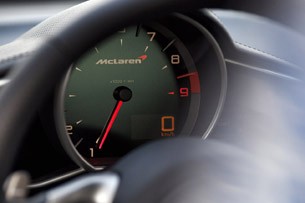
At the heart of the chassis is an all carbon-fiber MonoCell for the entire cockpit. This piece weighs just 165 pounds and provides rigidity in all directions that current Ferrari and Porsche models cannot approach. Besides the bolt-on front and rear aluminum structures, the body is made up of a combination of aluminum and resin composites – both being cheaper to fix than any ooo-la-la carbon fiber panels. The beetle-wing cantilevered composite doors open with a caress via sensors. Yes, we said caress.
She stops, too. Standard brakes are aluminum-lead compound platters (14.6- and 13.8-inch front and rear) that had us a little worried at the outset. They worked fine, however, mainly because of the overall lightness, but also because of the quite effective Air Brake that juts up from the rear spoiler (and which, while up like that, effectively blocks all rear-view visibility). After performing its duties, it juts back down to place. We felt no fading during our mad dashes, but the cars with the optional Brembo carbon ceramics were a plus all around. Not in any weight-saving capacity, but in just plain being able to hammer the brakes at the last possible moment all day and get on with world domination.
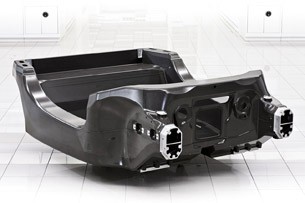
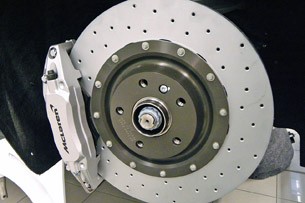
The list of lightening options includes: "superlight" wheels, the carbon-fiber sport seats (not yet available at launch), Pirelli P Zero Corsa tires, carbon ceramic brakes, carbon fiber splitter and diffuser and lighter sport muffler. The price on these remains TBD at the time of this writing. There are 18 total of color choices, five of these being of the optional Elite range.
It was about damn time that McLaren got into serious series car production. Only they and Ferrari have been part of every single F1 season since 1966, and now the battle royal can come to the streets, endurance races and weekend clubsport barbecues. And the MP4-12C is cheap at just $231,400 keys-in-hand before taxes and options. Bargain basement, oh, yeah.
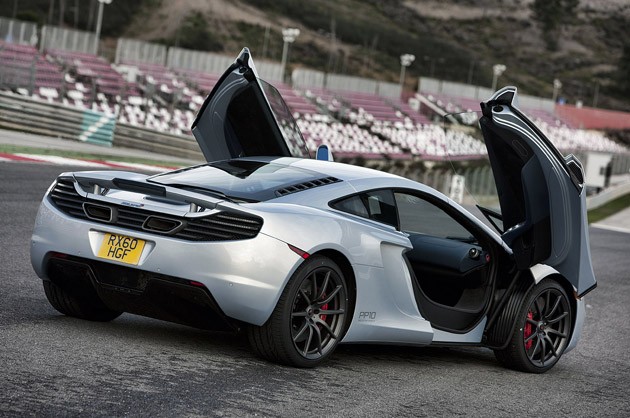
Total customer-destined production this year from Woking will be just 1,000 cars, one-third of those coming to the United States' nine giddy dealers. By 2015, so they say, full capacity of 4,000 per year will be reachable, that total being split between three separate models.
Does the MP4-12C beat all comers at the Nürburgring Nordschleife, though? No times were told, but all the Woking kids grinned a lot, saying even they were blown away at the margin of advantage. World-beater then? One thing's for certain: King Dennis will not be embarassed.
Photos courtesy McLaren Automotive
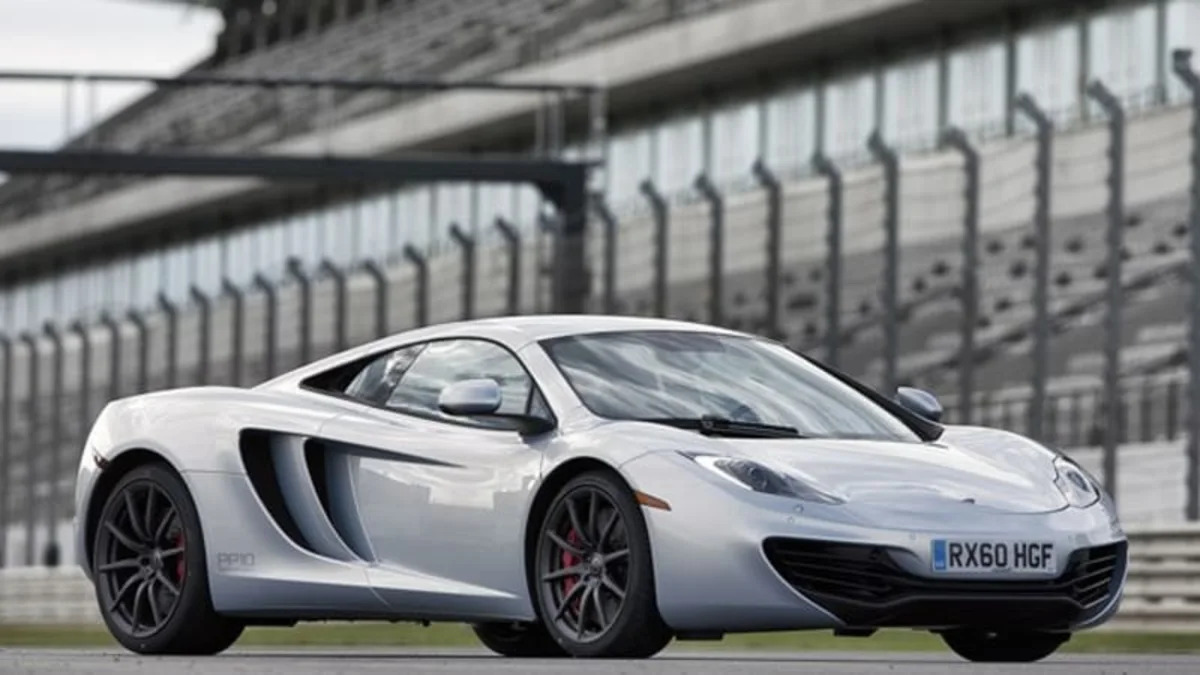
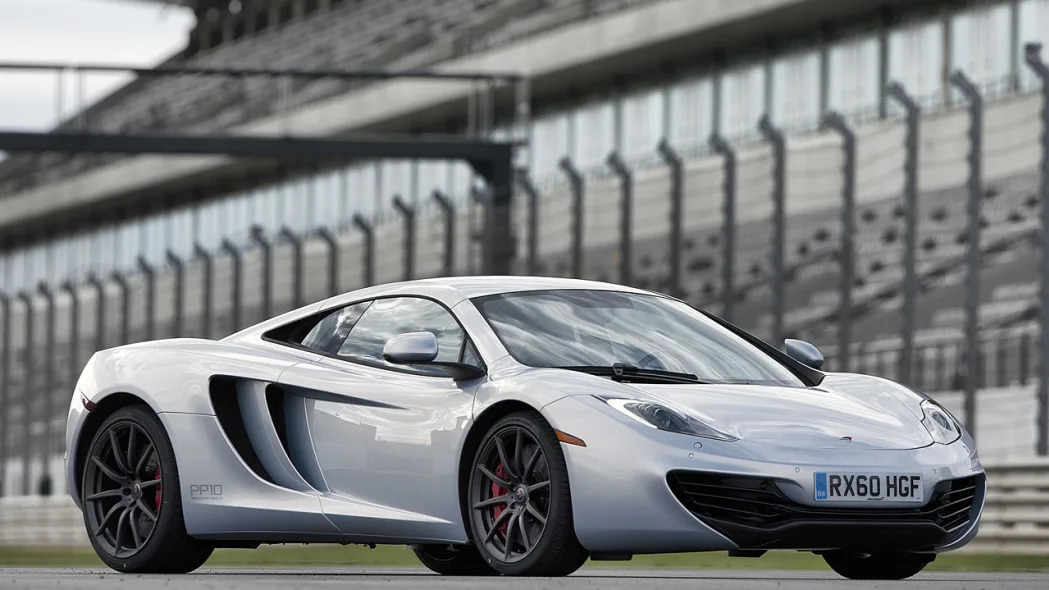

Sign in to post
Please sign in to leave a comment.
Continue